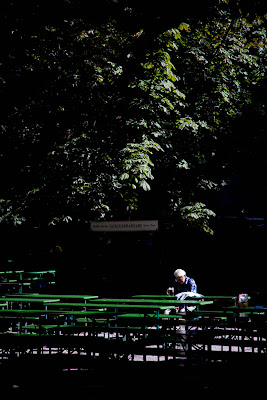Before doing any new photography, the first thing I did was to look back at my previous work for the AoP course. Prior to starting the course I would consciously avoid putting people into a picture wanting to capture the object and not the moment. I realized about a year ago that people add scale, movement, and a sense of place to photographs and so nowadays almost all of my shots include people. The following are 3 images created as part of Assignment 3 in AoP "Your Neighbourhood". I did not use any of them, however, for each of these landscapes I very deliberately waited until there was a single figure in the frame. The third photograph was taken at the same time as the photograph I have included in the header to this blog:
The first and third are pretty much the same vantage point, but taken about 3 months apart. In both cases the figure in the frame adds scale and some movement. It also leaves a feeling of emptiness in the landscape. The second image uses the person as a point of colour in an otherwise very flat image. He is not very sharp, but is still clearly a person.
More recently I have used the presence of a person to add either a point or a dimension to some of the images I worked on for assignment 3. The first photograph is a little girl walking up the immense staircase in the Brandhorst Museum, the second is a man emerging from the Neue Pinakothek museum of 19th century art.
As with the man wearing a red coat in the second image, a jogger can add a small splash of colour into an image. In this case the both people are running out of the frame, their faces hidden, they are anonymous.
Another way to bring attention to a person is if they are caught by the light in an otherwise shady area as this man is reading his paper and enjoying the first beer of the day. Without the figure the photograph would have limited interest, although even with it I admit it is a poor image.
This gentleman was enjoying a spot in the sun, the brightness is too high for an effective photograph.
Another grab shot of a man heading home from work at the end of the day. technically there are several people in this image but the eye is drawn to him as he occupies the point of perspective in the frame
The use of a single small figure in a frame can really add to an otherwise static composition. However, finding that single person is not always so easy and this is where our friend "Mr Spot Removal" comes in handy, indeed here he is really "Mr Person Removal". I rejected the following image for this exercise as it had two figures small in the foreground. The child feeding the ducks is pleasant, but the woman closer to the camera is doing something odd and looks out of place. I was shocked at how effective the spot removal was. I applied a single use of the same tool that I would under normal circumstances apply to removing sensor dust spots from images.
In a similar vein I decided to experiment with this image of a young couple enjoying the sun.
As I only wanted one person, spot removal quickly solved that problem
However, she is not where I want her in the frame, so second more careful use of the spot removal tool. It is possible in Lightroom to move the point from which the fill part of the spot is taken, all I did was remove a non-existent spot from the bottom left of the image and use the woman as the fill.
With the knowledge that I have done this, the changes can be seen, otherwise you would never know. At full resolution and blown up to 100% it is possible to see artifacts of the copy, but you have to look very closely and even then it is not obvious. The question of photographic truth has long since been answered, however, we are now entering a very different world in which quite sophisticated image manipulation become easy. I am not surprised at the advent of use once memory cards that prevent any image manipulation after shutter release - use of photographs in evidence must otherwise be truly dangerous.
On the other hand the possibilities for an artist to use this technology creatively are immense!

















No comments:
Post a Comment